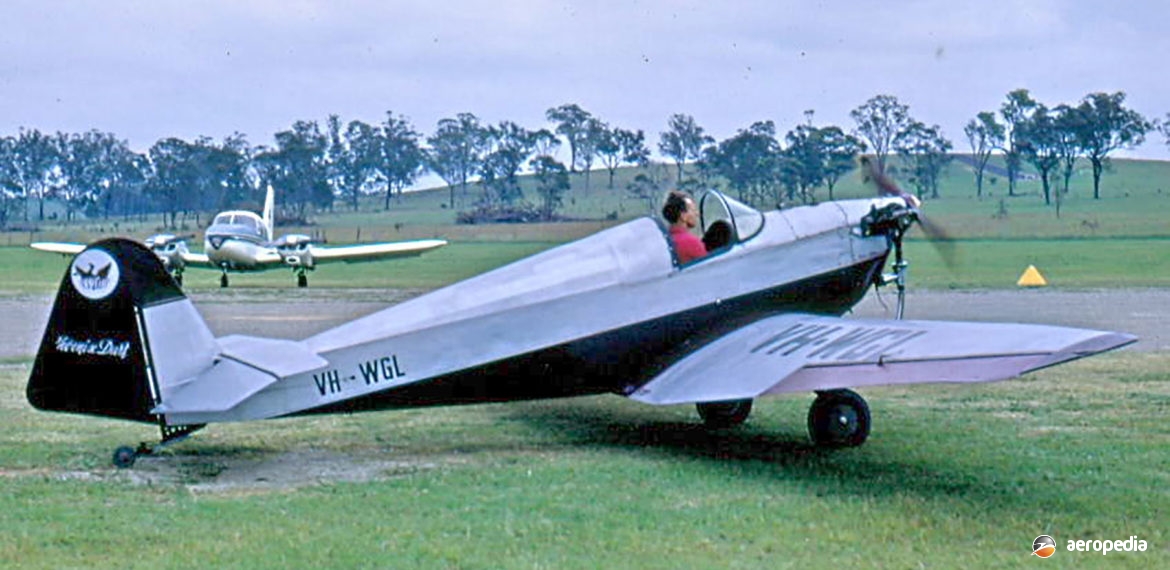Photograph:
Dart Kitten VH-WGL (c/n G.1) at Maitland, NSW (David C Eyre)
Country of origin:
United Kingdom
Description:
Single-seat light sport monoplane
Power Plant:
One 27 kw (36 hp) JAP J-99 two-cylinder four-stroke horizontally-opposed air-cooled engine
Specifications:
- Wingspan: 9.7 m (31 ft 9 in)
- Length: 6.5 m (21 ft 4 in)
- Height: 2.4 m (7 ft 11 in)
- Wing area: 11.98 m² (129 sq ft)
- Max speed: 153 km/h (95 mph)
- Cruising speed: 133 km/h (83 mph)
- Initial rate of climb: 183 m/min (600 ft/min)
- Stalling speed: 58 km/h (36 mph)
- Ceiling: 6,005 m (19,700 ft)
- Range: 547 km (340 miles)
- Empty weight: 200 kg (440 lb)
- Loaded weight: 309 kg (682 lb)
History:
The Dart Kitten sport monoplane was built by Dart Aircraft Limited at Dunstable in Bedfordshire in 1936 and the sole Mk I (G-AERP) flew for the first time on 15 January 1937 at Tollerton Airport, Nottingham. A few months later a re-designed and re-engined variant, the Mk II prototype (G-AEXT) was flown, and little development occurred until 1951 when the revised Mk II (G-AMJP) was built and registered in the United Kingdom.
Subsequently the aircraft was re-designed as the Mk III, and plans were offered for amateur construction. The fuselage was built up of four spruce longerons and wooden frames with plywood covering. The wing was a two-spar structure incorporating a plywood “D” nose leading-edge to give torsional stiffness. The remainder of the wing, apart from some plywood in the centre-section, was fabric covered. The fin and rudder were plywood covered, while all the control surfaces were fabric covered. The undercarriage used rubber blocks in compression for shock absorption. A 45.5 litre (10 Imp gal) fuel tank was located behind the firewall.
The Kitten could take off in about 82 m (270 ft) in still air and could climb away at 97 km/h (60 mph). A lever on the left side of the cockpit applied tension to the elevator controls allowing the aircraft to be trimmed to fly ‘hands off’ in any condition. Visibility was very good and, being a clean aircraft with no flaps, it had a tendency to float when landing.
In 1959 a New Guinea school teacher, Mr A P Baglee, built a Mk III VH-WGL (c/n G.1), being flown for the first time on 6 October 1959. It was flown for the next two years around Port Moresby until June 1962 when it was shipped in a Bristol 170 Freighter to Brisbane, QLD where it was re-assembled. The aircraft later had a couple of owners in the Newcastle, NSW area, eventually becoming based at Fairbairn in Canberra, ACT where it was withdrawn from service in about 1984. It was later stripped and burnt
Three further Kitten kits are known to have been imported to Australia but only VH-WGL was completed and registered. Commencement of construction of one was by Mr N Nash of Glenfield, NSW. It is believed to have reached an advance stage but is not known to have been completed. No airframe – c/n number was allotted but it did receive the registration VH-UMG.

